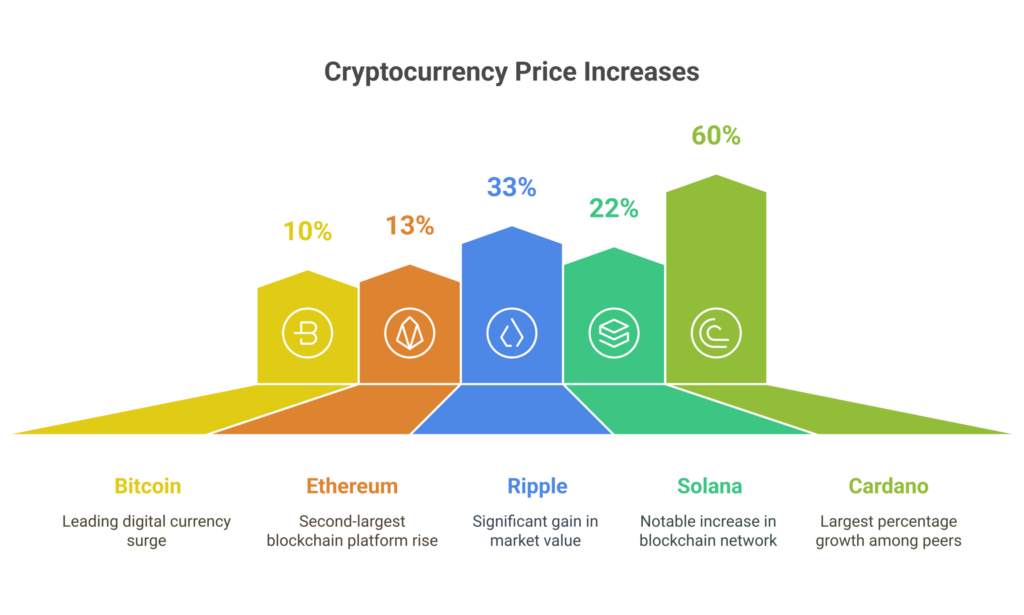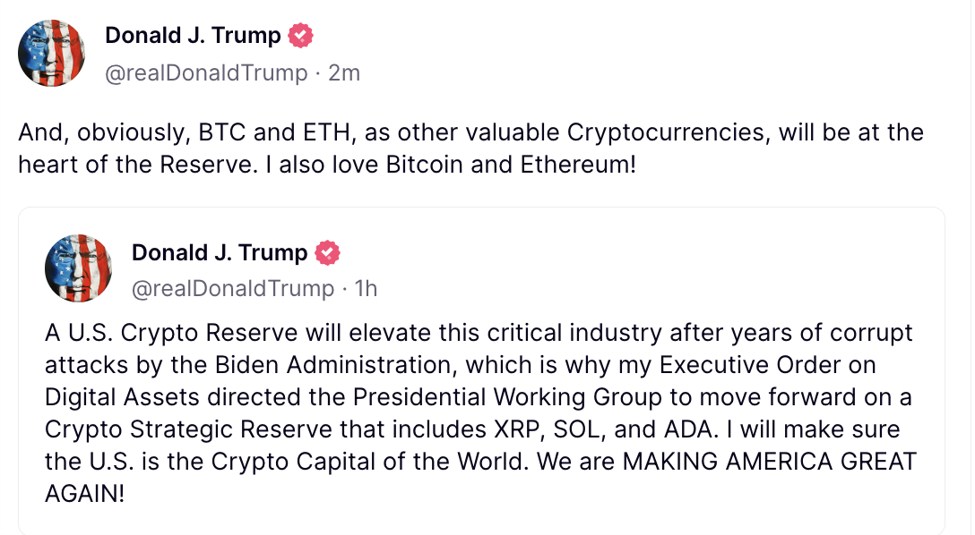America’s Crypto Revolution: Understanding Trump’s Strategic Reserve Announcement

A Bold New Direction for American Cryptocurrency
In a move that sent ripples through the digital asset world, President Donald Trump announced the creation of a “Crypto Strategic Reserve” on March 2, 2025.
The announcement, made via Truth Social, declared intentions to establish a national stockpile of cryptocurrencies including Bitcoin (BTC), Ethereum (ETH), Ripple (XRP), Solana (SOL), and Cardano (ADA). This initiative aims to position the United States as the “Crypto Capital of the World” and represents a significant shift in government stance toward digital assets.
Market Response: A Surge of Enthusiasm
The cryptocurrency market responded with immediate enthusiasm. Within hours of the announcement:
- Bitcoin surged over 10% to break $94,000
- Ethereum jumped more than 13% to approximately $2,516
- Ripple saw gains of 33%
- Solana increased by 22%
- Cardano experienced the most dramatic rise at over 60%

The total cryptocurrency market capitalization increased by approximately $300 billion, reflecting widespread investor confidence in this new direction.
The Foundations of the Strategic Reserve
This announcement didn’t come out of nowhere. It builds upon an executive order signed by President Trump on January 23, 2025, titled “Strengthening American Leadership in Digital Financial Technology.”

That order established the Presidential Working Group on Digital Asset Markets with two primary tasks:
- Proposing a federal regulatory framework for digital assets
- Evaluating the creation of a national digital asset stockpile
An intriguing aspect of the plan appears to be using cryptocurrencies already seized by the Federal Government through law enforcement efforts—valued at around $19 billion according to Arkham Intelligence—as a foundation for the reserve.
From Crackdown to Embrace: A Policy Reversal
The move represents a stark contrast to the previous administration’s approach to cryptocurrencies, which many in the industry characterized as restrictive. President Trump emphasized this point in his announcement, stating that the reserve “will elevate this critical industry after years of corrupt attacks by the Biden Administration.”
This shift toward embracing cryptocurrency innovation could have profound implications for American technological leadership and economic development, particularly in the rapidly evolving digital finance sector.
What Happens Next?
While the announcement has generated significant excitement, many questions remain about implementation details:
- Will the government limit the reserve to seized assets, or will it make additional purchases?
- How will the reserve be managed and by which agencies?
- What regulatory changes will accompany this initiative?
David Sacks, Trump’s appointed White House AI and Crypto Czar, has indicated that more details will be revealed at the upcoming White House Crypto Summit on March 7, 2025. This event will likely provide crucial information about the mechanics and scope of the reserve.
Broader Implications: A New Global Economic Landscape?
Beyond the immediate market impact, this initiative could have far-reaching implications:
Regulatory Clarity
A clearer regulatory framework could attract institutional investors who have been hesitant to enter the cryptocurrency space due to uncertainty. This could foster innovation and reduce friction for wider adoption of digital assets.
Increased Legitimacy
Government backing through an official reserve could enhance the credibility of cryptocurrencies, potentially leading to greater adoption by businesses and individuals. This aligns with Trump’s stated goal to make the US a leader in digital finance.
Global Competition
Some analysts suggest this move could trigger what they’re calling a “cryptocurrency arms race,” with other nations like Japan, Russia, and China potentially accumulating their own reserves. This could fundamentally reshape the global economic order, with digital assets playing a more central role in international finance.
Market Stability
Similar to how the Strategic Petroleum Reserve functions for oil markets, a crypto reserve could potentially be used to stabilize markets during periods of extreme volatility or crisis. However, the mechanics of how this would work—whether through releases or purchases—have not been defined.
A Mixed Reception
While sentiment is predominantly positive within the cryptocurrency community, reactions are not universally enthusiastic. Some Bitcoin and Ethereum purists have expressed surprise at the inclusion of smaller coins like XRP, SOL, and ADA. Critics question the fundamental qualities of some of the chosen assets, and some worry about potential market manipulation or increased volatility.
One analyst noted, “Unlike bitcoin…these assets are more akin to tech investments,” suggesting concerns about the selection criteria for the reserve’s composition.
The Road Ahead
As with any groundbreaking initiative, challenges remain. Legal and regulatory hurdles must be addressed, with debate ongoing about whether an act of Congress is necessary or if the reserve could be created through existing funds. Some analysts see potential conflicts with current financial regulations that will need resolution.
What’s clear is that this announcement represents a pivotal moment for cryptocurrencies in America. Whether it will deliver on its promise to make the United States the “Crypto Capital of the World” remains to be seen, but the immediate market response suggests strong confidence in this new direction.
For now, all eyes turn to the White House Crypto Summit on March 7, where we hope to gain greater clarity on how this bold vision will be implemented. Stay tuned for updates as this story continues to develop.
What are your thoughts on the Crypto Strategic Reserve? Will it cement America’s position as a leader in digital finance, or does it raise concerns about government involvement in cryptocurrency markets?
Key Citations:
